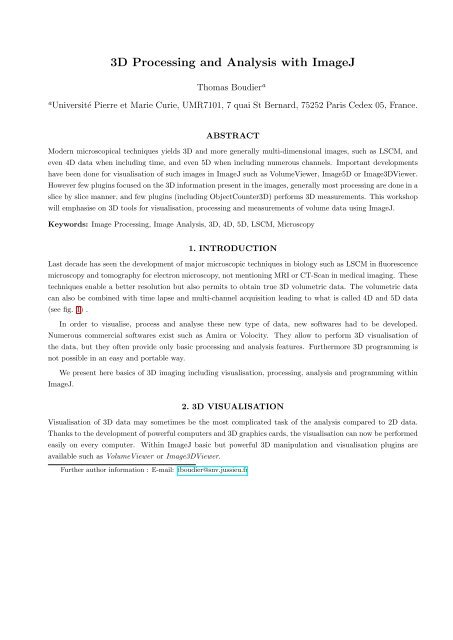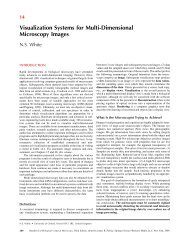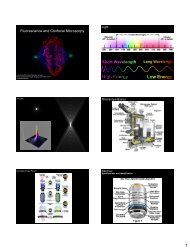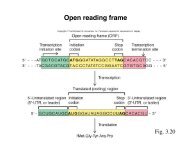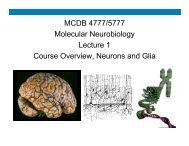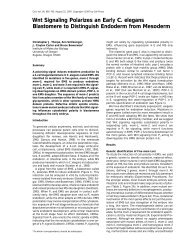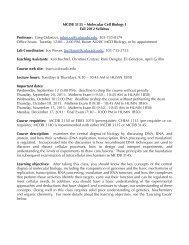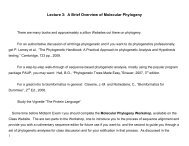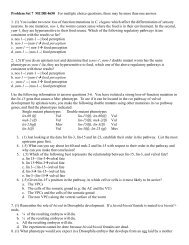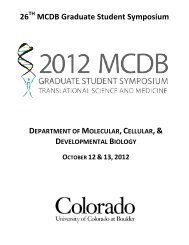3D Processing and Analysis with ImageJ
3D Processing and Analysis with ImageJ
3D Processing and Analysis with ImageJ
You also want an ePaper? Increase the reach of your titles
YUMPU automatically turns print PDFs into web optimized ePapers that Google loves.
<strong>3D</strong> <strong>Processing</strong> <strong>and</strong> <strong>Analysis</strong> <strong>with</strong> <strong>ImageJ</strong><br />
Thomas Boudier a<br />
a Université Pierre et Marie Curie, UMR7101, 7 quai St Bernard, 75252 Paris Cedex 05, France.<br />
ABSTRACT<br />
Modern microscopical techniques yields <strong>3D</strong> <strong>and</strong> more generally multi-dimensional images, such as LSCM, <strong>and</strong><br />
even 4D data when including time, <strong>and</strong> even 5D when including numerous channels. Important developments<br />
have been done for visualisation of such images in <strong>ImageJ</strong> such as VolumeViewer, Image5D or Image<strong>3D</strong>Viewer.<br />
However few plugins focused on the <strong>3D</strong> information present in the images, generally most processing are done in a<br />
slice by slice manner, <strong>and</strong> few plugins (including ObjectCounter<strong>3D</strong>) performs <strong>3D</strong> measurements. This workshop<br />
will emphasise on <strong>3D</strong> tools for visualisation, processing <strong>and</strong> measurements of volume data using <strong>ImageJ</strong>.<br />
Keywords: Image <strong>Processing</strong>, Image <strong>Analysis</strong>, <strong>3D</strong>, 4D, 5D, LSCM, Microscopy<br />
1. INTRODUCTION<br />
Last decade has seen the development of major microscopic techniques in biology such as LSCM in fluorescence<br />
microscopy <strong>and</strong> tomography for electron microscopy, not mentioning MRI or CT-Scan in medical imaging. These<br />
techniques enable a better resolution but also permits to obtain true <strong>3D</strong> volumetric data. The volumetric data<br />
can also be combined <strong>with</strong> time lapse <strong>and</strong> multi-channel acquisition leading to what is called 4D <strong>and</strong> 5D data<br />
(see fig. 1) .<br />
In order to visualise, process <strong>and</strong> analyse these new type of data, new softwares had to be developed.<br />
Numerous commercial softwares exist such as Amira or Volocity. They allow to perform <strong>3D</strong> visualisation of<br />
the data, but they often provide only basic processing <strong>and</strong> analysis features. Furthermore <strong>3D</strong> programming is<br />
not possible in an easy <strong>and</strong> portable way.<br />
We present here basics of <strong>3D</strong> imaging including visualisation, processing, analysis <strong>and</strong> programming <strong>with</strong>in<br />
<strong>ImageJ</strong>.<br />
2. <strong>3D</strong> VISUALISATION<br />
Visualisation of <strong>3D</strong> data may sometimes be the most complicated task of the analysis compared to 2D data.<br />
Thanks to the development of powerful computers <strong>and</strong> <strong>3D</strong> graphics cards, the visualisation can now be performed<br />
easily on every computer. Within <strong>ImageJ</strong> basic but powerful <strong>3D</strong> manipulation <strong>and</strong> visualisation plugins are<br />
available such as VolumeViewer or Image<strong>3D</strong>Viewer.<br />
Further author information : E-mail: tboudier@snv.jussieu.fr
Figure 1. Slice 8 from the 4D stack Organ of Corti that can be found as a sample image in <strong>ImageJ</strong>.<br />
<strong>3D</strong> manipulation <strong>and</strong> visualisation <strong>with</strong> <strong>ImageJ</strong><br />
<strong>ImageJ</strong> allows the manipulation of volume data via the Stacks submenu. It allows adding or removing slices, <strong>and</strong><br />
animate the data. It allows also projections of the data in the Z direction, projection permits to visualise all the<br />
<strong>3D</strong> data on one slice <strong>and</strong> increase signal to noise ratio. Volume image are represented as a succession of 2D slices<br />
in the Z direction, the data can be resliced in X <strong>and</strong> Y direction <strong>with</strong> the Reslice comm<strong>and</strong>. For reslicing it is<br />
important to take into account the spacing, i.e the size in Z of the voxel compared to its size in X − Y . Isotropic<br />
data are usually preferred for <strong>3D</strong> visualisation <strong>and</strong> analysis, however generally the ratio between Z spacing <strong>and</strong><br />
X − Y spacing is high, in order to reduce this ratio it is possible to reslice the data using the Reslice comm<strong>and</strong><br />
by specifying the input <strong>and</strong> output spacing accordingly. A volume image <strong>with</strong> additional interpolated slices will<br />
be obtained, of course these interpolated slices do not increase the qualitative resolution in the Z direction.<br />
In order to have an idea of the <strong>3D</strong> presence of objects inside the volume the simplest way is to make series of<br />
projections of the data. This will create series of projections of the data as if one was turning around the data<br />
<strong>and</strong> view it transparent at each of these angles, thanks to a animation our brain will reconstruct the whole <strong>3D</strong><br />
data. This can be done using the <strong>3D</strong> Project comm<strong>and</strong> <strong>with</strong> the mean value <strong>and</strong> Y axis options.<br />
The VolumeViewer plugin<br />
The VolumeViewer plugin allows more complex <strong>and</strong> interactive volume visualisation. Slices in any direction can<br />
be performed inside the volume, an orientation is chosen <strong>with</strong> the mouse <strong>and</strong> then one can scroll trough the<br />
volume adjusting the distance view. For volume visualisation a threshold must be chosen, the voxels above this<br />
value will be set as transparent,for other voxels the higher values the more opaque. The voxels that are visualised<br />
are set <strong>with</strong> the depth slider.<br />
The Image<strong>3D</strong>Viewer plugin<br />
The <strong>ImageJ</strong><strong>3D</strong>Viewer plugin requires the installation of Java<strong>3D</strong> <strong>and</strong> the presence of a <strong>3D</strong> Graphics card. It<br />
allows the visualisation at the same time of volume data, orthogonal slices <strong>and</strong> surfaces. In order to build
Figure 2. Two views <strong>with</strong> the Image<strong>3D</strong>Viewer plugin from the red <strong>and</strong> green canal of 4D stack of Fig. 1. Left : volume<br />
rendering, all voxels are visualised. Right : surface rendering, only thresholded voxels are seen, note that no variation of<br />
intensities is available.<br />
surfaces (meshes) a threshold must be chosen, a binary volume is build <strong>and</strong> voxels at the border of the binarized<br />
objects will be displayed. Transparencies between the various representations can be adjusted allowing a complete<br />
interactive view of multiple objects coming from the same or different volumes. Finally an animation of the <strong>3D</strong><br />
visualisation can be constructed interactively <strong>and</strong> recored as a AVI movie.<br />
HyperStacks manipulation : 4D <strong>and</strong> 5D<br />
Volume data incorporating time or multiple channels are called HyperStacks <strong>and</strong> can be manipulated <strong>with</strong>in<br />
<strong>ImageJ</strong>. The hyperStack can be projected in Z for all channels <strong>and</strong> times, however 4D or 5D visualisation is<br />
not (yet) possible <strong>with</strong> the <strong>3D</strong> Project comm<strong>and</strong>. For 4D visualisation, that is to say animation of several <strong>3D</strong><br />
dataset, the <strong>ImageJ</strong><strong>3D</strong>Viewer plugin can be used as well as other free softwares such as Voxx2.<br />
3. <strong>3D</strong> PROCESSING<br />
Volmetric data may present a signal to noise ratio lower than 2D data, hence some processing may be necessary<br />
to reduce noise <strong>and</strong> enhance signal. The theory of processing is essentially the same for 2D <strong>and</strong> <strong>3D</strong> data, it is<br />
based on the extraction of neighboring pixel values, the computation of the processed value from these values,<br />
<strong>and</strong> the application of this value to the central pixel of the neighbourhood. Basically in 2D the neighbourhood<br />
may be any symmetrical shape, usually a square or a circle. For <strong>3D</strong> images any symmetrical shape like brick or<br />
ellipsoid is used.<br />
The number of values to process in <strong>3D</strong> neighbourhood are quite larger than in 2D, for a neighbourhood<br />
of radius 3, 9 values are present in a 2D square <strong>and</strong> 27 in a <strong>3D</strong> cube. The time to process an image is then<br />
considerably increased from 2D to <strong>3D</strong>. Implementations procedure should be optimised <strong>and</strong> JNI programming<br />
can be used. JNI programming consists in writing time-consuming procedures in other languages like C, that is<br />
quite faster than Java.
Figure 3. “ THe stack of Fig. 1 was denoised by a <strong>3D</strong> median filter of radius 1. Left : volume rendering. Right : surface<br />
rendering, note that surfaces are smoother.<br />
In this section we describe commonly used filtering <strong>and</strong> morphological operators, but first a introduction to<br />
contrast adjustment.<br />
Brightness <strong>and</strong> contrast<br />
Brightness <strong>and</strong> contrast may be adjusted slice by slice to improve the visualisation of objects of interest. However<br />
changes in contrast may be present from slice to slice due to the acquisition procedure, like decrease of fluorescence<br />
for LSCM or increase of thickness in tilted series for electron tomography. These changes in contrast can be<br />
modelled <strong>and</strong> the contrast can be corrected based on the model. The contrast can be also automatically adjusted<br />
from slice to slice thanks to the Normalise All slice comm<strong>and</strong> of the Enhance Contrast function. This procedure<br />
will process the data so that the the slices will have roughly the same mean <strong>and</strong> st<strong>and</strong>ard deviation, correcting<br />
hence any changes in contrast trough the data.<br />
Noise reduction<br />
Volume data can be 2D-filtered in a slice by slice manner, this can produce fast satisfactory results but in some<br />
cases, where the signal to noise ratio is quite low, a <strong>3D</strong> filtering should be favoured. Very weak signals are present<br />
in <strong>3D</strong>, that is to say on adjacent slices, they may however be almost indistinguishable in 2D due to noise. Only<br />
a <strong>3D</strong> filtering can take into account the <strong>3D</strong> information of the signal <strong>and</strong> reduce the noise. Classical filters used<br />
for reducing noise are mean, gaussian or median filters. Median filter can be favoured since it is more robust to<br />
noise <strong>and</strong> preserve the edges of the objects, it is specially powerful on noisy confocal data images.<br />
The radius of filtering should be chosen accordingly to the size of the objects of interest since filtering reduces<br />
noise but also may suppress small objects, the smaller the objects the lower the radius. The choice of the radius<br />
obeys the same rule in 2D as in <strong>3D</strong>. However due to the acquisition systems, objects tend to be a bit elongated<br />
in Z compared to X − Y , furthermore the spacing is generally different in Z than in X − Y so round objects do<br />
not have the same radius in pixels in Z than in X − Y , the radius of filtering should hence be different in the<br />
two directions. The radii of the neighborhood kernel can also be optimally computed for each voxel in order to
fit inside a probable object <strong>and</strong> avoiding averaging between signals <strong>and</strong> background. Such procedures are part<br />
of anisotropic filtering,<br />
Morphology<br />
Mathematical morphology is originally based on complex mathematical operations between sets, however applied<br />
to images it can be seen as a particular type of filtering. Morphological operations are to be applied to binarized<br />
images <strong>and</strong> work on the objects segmented by the binarization. However many operations can be extended to<br />
grey-level images. The basic operation of mathematical morphology is called dilatation <strong>and</strong> consist in superim-<br />
posing a kernel to every pixel of the image, <strong>and</strong> if any of the pixel in the kernel is part of an object then the<br />
centre of the kernel turns to the objects value. Contrary to filtering the kernel does not need to be symmetrical,<br />
however usually a symmetrical kernel is used. The inverse operation of dilatation is called erosion, the centre of<br />
the kernel turns to the background value if any of the pixel inside the kernel is part of the background. For <strong>3D</strong><br />
morphology the kernel is a <strong>3D</strong> shape, usually a ellipsoid or a <strong>3D</strong> brick.<br />
Actually useful moprhological operations are a combination of the two basics operation, for instance closing<br />
consists in a dilatation followed by an erosion <strong>and</strong> permits to make the objects more compact <strong>and</strong> fills small holes<br />
inside objects. The twin operation opening, a erosion followed by a dilatation, permits to remove small spots in<br />
the background. Other useful operations are fill holes to suppress any hole present <strong>with</strong>in an object, distance<br />
map to compute for any pixel its distance to the closest edge or tophat to enhance spots. This operation consists<br />
in computing a local background image by removing the objects, <strong>and</strong> then to perform the difference between<br />
the original image <strong>and</strong> the computed background. In the case of bright spots the background is computed by<br />
performing a minimum filter, equivalent to an erosion, hence removing any bright signal. The size of the kernel<br />
must therefore be larger that the object size. This procedure is quite powerful in <strong>3D</strong> to detect fluorescence signals<br />
like F.I.S.H. spots.<br />
Other processing<br />
Any procedure that processes a 2D image via a kernel can be quite directly adapted to <strong>3D</strong> data, however the<br />
main concern is time <strong>and</strong> memory requirements since a <strong>3D</strong> image can be hundred times bigger than a 2D image.<br />
Another purpose of filtering is edge detection, in 2D a classical way to detect edges is to compute edges in<br />
both X <strong>and</strong> Y directions <strong>and</strong> then combine them to find the norm of the gradient corresponding to the strength<br />
of the edges, the angle of the edges can also be computed from the X <strong>and</strong> Y differentials. For <strong>3D</strong> edges the<br />
differential in Z is added to the X <strong>and</strong> Y ones.<br />
δx(i, j, k) ≈ I(i + 1, j, k) − I(i − 1, j, k),<br />
δy(i, j, k) ≈ I(i, j + 1, k) − I(i, j − 1, j),<br />
δz(i, j, k) ≈ I(i, j, k + 1) − I(i, j, k − 1),<br />
edge = δx 2 + δy 2 + δz 2<br />
Fourier processing<br />
The above cited processing were performed on the real images, other processing can be performed on the Fourier<br />
transform of the image. The Fourier transform of the image corresponds to the frequencies inside the real image,<br />
so, in another way, to the various sizes of objects present in the image. In order to reduce noise objects <strong>with</strong> very<br />
small sizes, hence high frequencies, can be deleted using a low pass filter. To enhance objects <strong>with</strong> a particular
size b<strong>and</strong> pass filtering can be performed, see the B<strong>and</strong>pass Filter in the FFT menu. The Fourier Transform<br />
can also be computed in <strong>3D</strong>, however the computation time can be quite long if non power of 2 images are used.<br />
Other applications of Fourier Transform are signal deconvolution <strong>and</strong> correlation computations, that permits to<br />
find the best displacement in X, Y <strong>and</strong> Z between two volumes.<br />
For stack alignment the computation of the <strong>3D</strong> translation between two volumes can be easily computed<br />
in Fourier Space, however for computation of <strong>3D</strong> rotation the problem is quite more complex than in 2D since<br />
3 angles, around each axis, must be computed. Complex optimisation algorithm should be used, iterative<br />
procedures including translation <strong>and</strong> rotations estimations are generally used, see the StackAlignment plugin.<br />
4. <strong>3D</strong> SEGMENTATION<br />
Segmentation is the central procedure in image analysis. It permits to give a meaning to an image by extracting<br />
the objects, that are actually no more than a set of numeric values. The labelling of pixels to a numbered object<br />
or to background is the most difficult task of image analysis since we have to teach the computer what are<br />
objects, for instance what is a cell, what is a nucleus, what is an axon <strong>and</strong> so on.<br />
The task is quite more complicated in <strong>3D</strong> since it is more difficult to describe a <strong>3D</strong> shape than a 2D one. To<br />
perform the labelling of objects, two main approaches can be used; first objects can either be drawn manually<br />
either extracted based on their voxels values. Active contours model, known as snakes, is a semi-automatic<br />
approach where the user draw a rough initial shape <strong>and</strong> the computer will try to deform this shape to best fit<br />
the surrounding contour.<br />
Thresholding<br />
If the objects have homogeneous pixel values <strong>and</strong> if the values are significatively different from the background, a<br />
thresholding can be applied. In the case of an inhomogeneous illumination of the image the Substract Background<br />
procedure should be used. The Adjust Threshold tool helps in determining the threshold, an interval of values is<br />
manually selected <strong>and</strong> the thresholded pixels, corresponding to the objects, are displayed in red colour. Automatic<br />
threshold can be computed using various algorithms like IsoData, Maximum of Entropy, Otsu,<br />
Thresholding in <strong>3D</strong> obeys the same rules, however the object may present intensity variation in the Z<br />
direction. This variation can be corrected by a normalisation procedure (see 3). An automatic calculation of the<br />
threshold can also be computed in each individual slices, but due to normal variation of objects intensities in Z<br />
this procedure is not well adapted for <strong>3D</strong> segmentation.<br />
After thresholding, objects should be labelled, that is to say numbered. The Analyse Particles procedure<br />
perform this task in 2D, it can be applied to <strong>3D</strong> but it will label objects in each slices not taking into account<br />
the third dimension. Furthermore objects that look separated in 2D may be part of the same object in <strong>3D</strong>,<br />
for instance a simple banana shape may present its two ends separated in a 2D section. Hence a true <strong>3D</strong><br />
labelling should be performed, the plugin ObjectCounter<strong>3D</strong> will both threshold <strong>and</strong> label the objects in <strong>3D</strong>. It<br />
also computes geometrical measures like volume <strong>and</strong> surfaces.<br />
Manual segmentation<br />
In some cases the objects can not be thresholded in a satisfying way. Morphology procedures (see 3) may<br />
improve the binarization result, but for some complex objects, as ones observed by electron microscopy, a<br />
manual segmentation is required. The user have to draw in each slices the contours of the different objects.
Figure 4. Output of the sample data from fig. 1 <strong>with</strong> the ObjectCounter<strong>3D</strong> plugin, objects are segmented in <strong>3D</strong> <strong>and</strong><br />
labelled <strong>with</strong> an unique index, displayed here <strong>with</strong> a look-up table. Left : red channel, note that some objects are fused.<br />
Right : green channels, note all that fibers form only one object.<br />
Some plugins can help the user in this task such as QuickvolII mainly for MRI, TrackEM2 (see Workshop on this<br />
subject) or SegmentationEditor, other free tools exist like IMOD mainly specialised in electron microscopy data.<br />
Semi-automatic segmentation : active contours<br />
Active contours models, known as snakes, are semi automatic techniques that can help the user automate a<br />
manual segmentation. The user draws the initial model close to the object he wants to segment, the algorithm<br />
will then try to deform this initial shape so that it fits onto the contours of the image. Many algorithms are<br />
available as plugins such as IVUSnake, Snakuscule, or ABSnake.<br />
Snakes model, though developed for 2D data, can be used in <strong>3D</strong> in a iterative manner. The user draws an<br />
initial shape on the first slice of the volume, the algorithm will then segment the object, this segmentation on<br />
the first slice can be used as the initial shape for the next slice, <strong>and</strong> so on. However this method does not take<br />
into account the <strong>3D</strong> information <strong>and</strong> the links that exist between adjacent slices. Furthermore in the case of<br />
noisy data or problem in acquisition an object can be missing or deformed in a particular slice. The slice by slice<br />
approach can not alleviate this problem, a real <strong>3D</strong> procedure that take into account data in adjacent slices, as<br />
it is done in X − Y should be used. The plugin ABSnake<strong>3D</strong> uses such an approach, the model is a set of points<br />
lying in the different slices. For each iteration the point will move towards the contours of the image while being<br />
constrained in X − Y by its two neighboring points <strong>and</strong> also in Z by the two closest points in the upper <strong>and</strong><br />
lower slices.<br />
5. <strong>3D</strong> ANALYSIS<br />
Once the objects have been segmented the analysis can be performed. This part will compute geometrical <strong>and</strong><br />
pixel-based measures for each individual object. These measures must be performed using the real units of the<br />
image. The image should hence be calibrated in the 3 dimensions thanks to the Image/Properties window.
Figure 5. The <strong>3D</strong>Manager plugin in action. Objects are added to the manager via the segmented image of fig. 4. The<br />
objects 6 <strong>and</strong> 10 were selected <strong>and</strong> measured. Geometrical measures appear in the <strong>3D</strong> Measure results window, the canal<br />
1 window was selected <strong>and</strong> intensity measures from this image appear in the <strong>3D</strong> quantif results window.<br />
Geometrical features<br />
The geometrical features concern the shape of the object <strong>with</strong>out taking into account its intensitiy values. Basic<br />
measures are volume <strong>and</strong> area. Volume is actually the number of voxels belonging to the object <strong>and</strong> can be<br />
computed as the sum of 2D areas multiplied by the Z spacing. The area of a <strong>3D</strong> object corresponds to the<br />
number of voxels at its border, however the border can be defined in several ways, for instance allowing diagonal<br />
voxels or not, <strong>and</strong> hence the computation of area may vary from a program to another. From this basic measures<br />
one can compute the <strong>3D</strong> sphericity which is an extension of 2D circularity, <strong>and</strong> is computed from the ratio of<br />
volume over area. The sphericity, as well as the circularity, is maximal <strong>and</strong> equals 1 for a sphere : S 3 =<br />
<strong>with</strong> S being the sphericity, V the volume <strong>and</strong> A the area.<br />
2<br />
36.Π.V<br />
A3 ,<br />
Other measures like Feret diameter or ellipsoid fitting can not be computed from 2D slices, contrary to volume<br />
or area. Feret diameter is the longest distance from two contour points of the <strong>3D</strong> object. In order to have an<br />
idea of the global orientation of the object the fitting a <strong>3D</strong> ellipsoid can be used. Actually the main axes of the<br />
<strong>3D</strong> shape can be computed as the eigen vectors of the following moments matrix :<br />
<strong>with</strong> :<br />
⎛<br />
⎞<br />
sxx sxy sxz<br />
⎜<br />
⎟<br />
⎝syx<br />
syy syz⎠<br />
szx szy szz
Figure 6. Distance computation <strong>with</strong> the <strong>3D</strong>Manager plugin. The objects from red <strong>and</strong> green channels were added to<br />
the manager. The distances between objects 6 <strong>and</strong> 10 from red canal <strong>and</strong> object 1 (representing the fibers) from green<br />
canal were computed. From border to border distances one can see that object 10 touches the fibers.<br />
sxx = (x − cx).(x − cx),<br />
syy = (y − cy).(y − cy),<br />
szz = (z − cz).(z − cz),<br />
sxy = syx = (x − cx).(y − cy),<br />
sxz = szx = (x − cx).(z − cz),<br />
syz = szy = (y − cy).(z − cz),<br />
x, y <strong>and</strong> z being the coordinates of the points belonging to the object, cx, cy, cz being the coordinates of the<br />
barycentre of the object. The 3 eigen vectors will correspond to the 3 main axes of the shape. An elongation<br />
factor can be computed as the ratio between the two eigen values of the two first main axes.<br />
Other geometrical measures can give valuable information like distances between objects. The distances can<br />
be computed from centre to centre, or from border to border giving the minimal distance between objects. One<br />
may also be interested by the distance from the centre of an object to the border of another, or the distance<br />
along a particular direction. One may also be interested in the percentage of inclusion of an object into another,<br />
<strong>and</strong> so on.<br />
Finally the shape of the envelope of the object can be studied, in 2D this envelope correspond to the perimeter<br />
of the object <strong>and</strong> can be mathematically analysed as a curve, hence information like curvature can be computed.<br />
In <strong>3D</strong> such analysis is quite more complex since the border corresponds to a mathematical surface, <strong>and</strong> for<br />
instance for each point of a surface there are two curvatures instead of one.<br />
Intensity features<br />
The above geometrical measures do not not take into account the intensity of the voxels inside the object. In<br />
the case of an inhomogeneous distribution of the gray-levels inside the objects, intensity-based measure may<br />
be needed. For instance Integrated Density, which is the volume multiplied by the mean voxel value inside the<br />
object, <strong>and</strong> correspond to the sum of intensities inside the object. Mass centres are the barycenter of the voxels
Ip.x<br />
weighted by the pixel intensities : MCx = , where Ip is the intensity at point p belonging to the object<br />
Ip<br />
<strong>and</strong> x its x-coordinate, same applies for y <strong>and</strong> z.<br />
Main axes can also be computed by weighting all coordinates by the voxel value. Note that in most cases, due<br />
to the segmentation process, the object present homogeneous intensities <strong>and</strong> hence intensity-based barycenter<br />
<strong>and</strong> axes does not differ much from those computed in the above paragraph where actually all voxels are weighted<br />
by a factor of 1.<br />
Morphological analysis<br />
A first application of mathematical morphology is the computation of <strong>3D</strong> local thickness based on the distance<br />
map. For each point inside the object its minimum distance to the border can be used as an estimate to the<br />
maximal sphere that can be fitted at this point inside the object.<br />
Mathematical morphology can be used to fill holes inside objects or make them more compact, it can also<br />
be used to have a estimate of the sizes of the objects present in the volume <strong>with</strong>out to segment them. The<br />
technique, called granulometry, is based on the idea that objects processed by an erosion greater than the radius<br />
of the object will disappear. For grey-levels volumes, an erosion is actually a minimum filter, hence if bright<br />
objects are present in the image, <strong>and</strong> if the radius of the minimum filter is greater than the radius of the object,<br />
the minimum value inside the neighbourhood will be in the background. This will occur for any pixel inside the<br />
object <strong>and</strong> hence the object will tend to disappear. Therefore computing series of opening, an erosion followed<br />
by a dilatation, will produce series of filtered images, <strong>and</strong> the image that will differ much from the original<br />
will correspond to the disappearing of many objects, the corresponding radius of opening will correspond to the<br />
radius of some objects present in the volume. If many objects are present <strong>with</strong> different radii, for each particular<br />
radius the image will change. The same can be done <strong>with</strong> series of closing, dilatation followed by an erosion, in<br />
this case, radius of background will be detected, that is to say distances between objects.<br />
6. <strong>3D</strong> PROGRAMMING<br />
Many, if not all, operations implemented in <strong>ImageJ</strong> can be performed on <strong>3D</strong> data on a slice by slice manner.<br />
Hence macro recording should be sufficient to record series of processing performed on a stack by either <strong>ImageJ</strong><br />
or plugins. For <strong>3D</strong> analysis access to all the slices is often required. This can be done in macros using the slices<br />
comm<strong>and</strong>s, <strong>and</strong> the ImageStack class in plugins.<br />
Macros<br />
In order to manipulate a stack, the different slices corresponding to different z should be accessed. This can be<br />
done using the macro comm<strong>and</strong> setSlice(n) where n is the slice number between 1 <strong>and</strong> the total number of<br />
slices. The current displayed slice can be retrieved using the comm<strong>and</strong> getSliceNumber(), nSlices is a built-in<br />
variable corresponding to the total number of slices. In order to scroll trough the slices a loop is required, a loop<br />
is constructed by the for comm<strong>and</strong> : for(index=start;index
areamax=0;<br />
slicemax=start;<br />
run("Set Measurements...", "area redirect=None decimal=3");<br />
for(slice=start;sliceareamax){<br />
}<br />
areamax=area;<br />
slicemax=slice;<br />
write("Max area at slice "+slicemax);<br />
getVoxelSize(sizex,sizey,sizez,unit);<br />
write("Max area at z "+slicemax*sizez+" "+unit);<br />
For 4D <strong>and</strong> 5D data, the macro functions Stack. should be used. The various dimensions, that is to say the<br />
width, height, number of channels, number of slices <strong>and</strong> number of times, can be retrieved using the function<br />
Stack.getDimensions(width,height,channels,slices,frames). The equivalent of setSlice(n) is simply<br />
Stack.setSlice(n) for HyperStacks, similarly the functions Stack.setChannel(n) <strong>and</strong> Stack.setFrame(n)<br />
will change the channel <strong>and</strong> timepoint. The different information can be set using one function<br />
Stack.setPosition(channel,slice,frame) <strong>and</strong> retrieved by the function<br />
Stack.getPosition(channel,slice,frame). The same macro is rewritten supposing a 4D data :<br />
Stack.getPosition(channel,slice,frame);<br />
startTime=frame;<br />
startZ=slice;<br />
Stack.getDimensions(w,h,channels,slices,frames);<br />
endTime=frames;<br />
endZ=slices;<br />
run("Set Measurements...", "area redirect=None decimal=3");<br />
getVoxelSize(sizex,sizey,sizez,unit);<br />
for(time=startTime;time
}<br />
Plugins<br />
}<br />
}<br />
areamax=area;<br />
slicemax=slice;<br />
write("For time "+time+" Max area at slice "+slicemax);<br />
write("For time "+time+" Max area at z "+slicemax*sizez+" "+unit);<br />
Plugins are more adapted than macros to implement new processing procedures since the pixels access is quite<br />
faster. The Java class that stores stacks is called ImageStack, the stack can be retrieved from the current<br />
ImagePlus window :<br />
// get current image <strong>and</strong> get its stack<br />
ImagePlus plus=IJ.getImage();<br />
ImageStack stack=plus.getStack();<br />
The dimensions of the stack can be obtained using the methods getWidth(), getHeight() <strong>and</strong> getSize():<br />
int w=stack.getWidth();<br />
int h=stack.getHeight();<br />
int d=stack.getSize();<br />
IJ.write("dimensions : "+w+" "+h+" "+d);<br />
slice :<br />
In order to access the pixels values one has to access first the slice of interest <strong>and</strong> then the pixel inside this<br />
int x,y,z;<br />
x=w/2; y=h/2; z=d/2;<br />
ImageProcessor slice=stack.getProcessor(z+1);<br />
int val=slice.getPixel(x,y);<br />
IJ.write("The central pixel has value : "+val);<br />
Note that the slice number in the getProcessor method starts at 1 <strong>and</strong> not 0. Following is an example of a <strong>3D</strong><br />
mean filtering :<br />
int p0,p1,p2,p3,p4,p5,p6,mean;<br />
ImageStack filtered=new ImageStack(w,h);<br />
ImageProcessor filteredSlice;<br />
ImageProcessor slice, sliceUp, sliceDown;<br />
for(int k=2;k
}<br />
filteredSlice=new ByteProcessor(w,h);<br />
for(int i=1;i
stack is a stack containing segmented objects, each one having a particular grey-level<br />
// for instance coming from ObjectCounter<strong>3D</strong><br />
IntImage<strong>3D</strong> seg = new IntImage<strong>3D</strong>(stack);<br />
// create the object 1, which corresponds to segmented voxels having values 1<br />
obj = new Object<strong>3D</strong>(seg, 1);<br />
// compute barycenter<br />
obj.computeCenter();<br />
// compute borders<br />
obj.computeContours();<br />
// get barycenter<br />
float bx = obj.getCenterX();<br />
float by = obj.getCenterY();<br />
float bz = obj.getCenterZ();<br />
// get the feret’s diameter<br />
double feret = obj.getFeret();<br />
// construct an sphere <strong>with</strong> pixel value 255 centered on barycenter <strong>and</strong> <strong>with</strong> radius=feret<br />
ObjectCreator<strong>3D</strong> sphere = new ObjectCreator<strong>3D</strong>(w, h, d);<br />
obj.createEllipsoide(bx, by, bz, feret, feret, feret, 255);<br />
new ImagePlus("Sphere", sphere.getStack()).show();<br />
APPENDIX A. LIST OF PLUGINS<br />
• VolumeViewer : http://rsbweb.nih.gov/ij/plugins/volume-viewer.html<br />
• <strong>ImageJ</strong><strong>3D</strong>Viewer <strong>and</strong> <strong>3D</strong> Segmentation Editor : http://www.neurofly.de/<br />
• Image5D : http://rsbweb.nih.gov/ij/plugins/image5d.html<br />
• IJ<strong>3D</strong> processing <strong>and</strong> analysis : http://imagejdocu.tudor.lu/doku.php<br />
• StackAlignment : http://www.med.harvard.edu/JPNM/ij/plugins/Align3TP.html<br />
• ObjectCounter<strong>3D</strong> : http://rsbweb.nih.gov/ij/plugins/track/objects.html<br />
• ABSnake : http://imagejdocu.tudor.lu/doku.php?id=plugin:segmentation:active_contour:start<br />
• LiveWire <strong>and</strong> IVUSnake : http://ivussnakes.sourceforge.net/<br />
• Snakuscule : http://bigwww.epfl.ch/thevenaz/snakuscule/<br />
• TrackEM2 : http://www.ini.uzh.ch/~acardona/trakem2.html<br />
• QuickVol II : http://www.quickvol.com/
APPENDIX B. OTHER PROGRAMS<br />
• IMOD <strong>3D</strong> segmentation <strong>and</strong> visualisation : http://bio3d.colorado.edu/imod/<br />
• Voxx2 <strong>3D</strong> <strong>and</strong> 4D visualisation : http://www.nephrology.iupui.edu/imaging/voxx/<br />
• <strong>3D</strong> molecular visualisation : http://www.cgl.ucsf.edu/chimera/<br />
• Etdips <strong>3D</strong> medical analysis <strong>and</strong> visualisation : http://www.cc.nih.gov/cip/software/etdips/<br />
ACKNOWLEDGMENTS<br />
I would like to thanks all <strong>3D</strong> developers for <strong>ImageJ</strong>. Special thank to C. Messaoudi who developed the first<br />
version of the ij3d library <strong>and</strong> P. Andrey for fruitful discussion <strong>and</strong> the implementation of the <strong>3D</strong> version of<br />
ABSnake.


